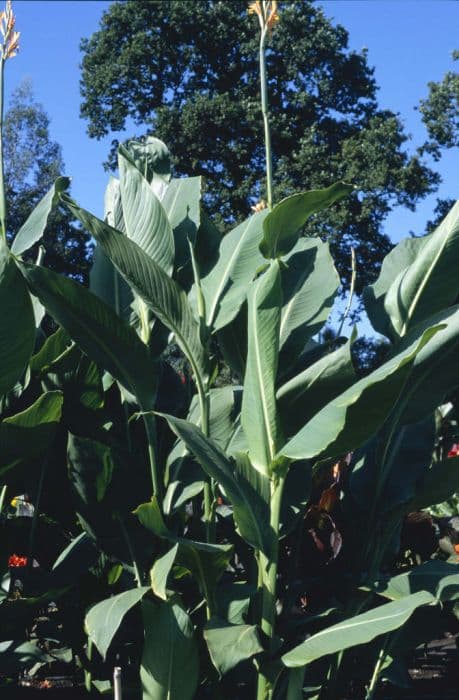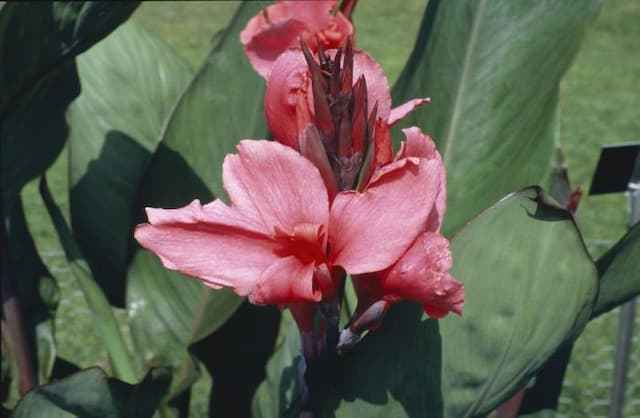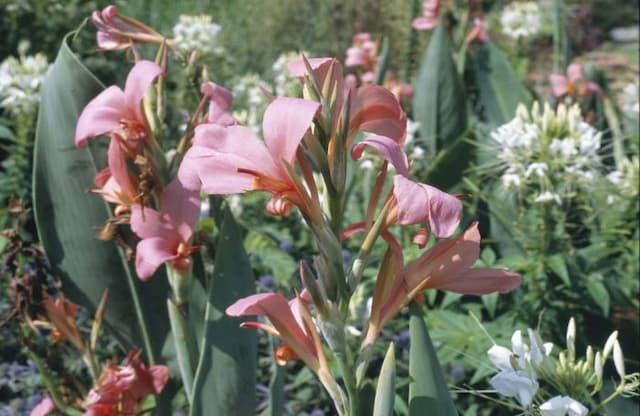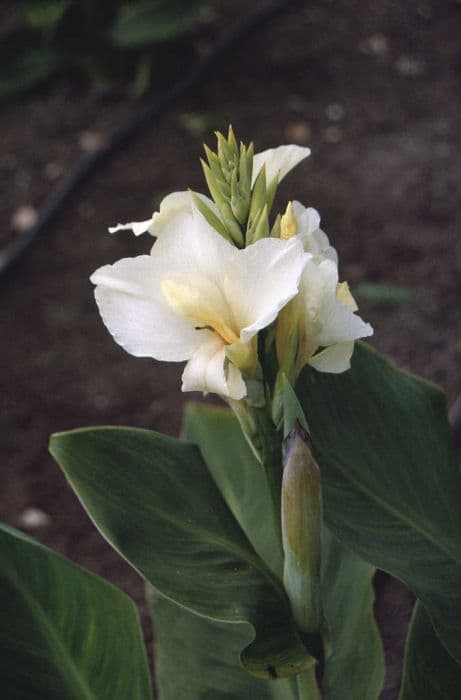Canna Lily Canna 'Brillant'

ABOUT
Canna 'Brillant' is a striking plant known for its vibrant, fiery-hued blossoms that resemble iris flowers. The petals are typically a rich, bright red with a slight sheen that catches the light, making them stand out in any garden setting. Each flower is often complemented with a golden or yellow throat, which adds to its allure and provides a warm contrast to the red petals. The foliage of Canna 'Brillant' is equally impressive, with large, banana-like leaves that come in various shades of green. Some varieties may also have burgundy or deep bronze-tinted leaves, adding to the plant's overall dramatic appearance. The leaves have a broad, elongated shape and can be quite lush, creating a dense and tropical-looking backdrop for the stunning flowers. Canna 'Brillant' typically blooms from early summer through to the first frosts of fall, producing flowers in clusters atop tall, sturdy stalks that emerge from the foliage. The flower spikes are surrounded by the large leaves, which helps showcase the bright blossoms. The plant overall has a bold and exotic look, making it a popular choice for gardeners looking to add a splash of color and a tropical touch to their landscapes.
About this plant
 Names
NamesFamily
Cannaceae.
Synonyms
Canna Lily, Indian Shot, Canna.
Common names
Canna 'Brilliant'.
 Toxicity
ToxicityTo humans
Canna 'Brilliant', commonly known as Canna Lily, is not generally considered toxic to humans. There are no well-documented toxicity symptoms associated with ingesting this plant. However, it is always recommended to avoid eating ornamental plants as a precaution.
To pets
Canna Lily is not known to be toxic to pets either. While it is not common for pets to ingest this plant, if they do, they are unlikely to suffer from poisoning. As with any non-food plant, ingestion might potentially cause mild stomach upset, but significant toxicity is not expected.
 Characteristics
CharacteristicsLife cycle
Perennials
Foliage type
Deciduous
Color of leaves
Green
Flower color
Mixed
Height
3-4 feet (0.9-1.2 meters)
Spread
1-2 feet (0.3-0.6 meters)
Plant type
Bulb
Hardiness zones
7-10
Native area
South America
Benefits
 General Benefits
General Benefits- Ornamental Value: Canna 'Brilliant' adds vibrant color and dramatic texture to gardens with its bright red flowers and lush foliage.
- Easy to Grow: This plant is known for being low maintenance and easy to cultivate, even for novice gardeners.
- Rapid Growth: It grows quickly, providing fast coverage or filling in garden spaces efficiently.
- Drought Tolerant: Once established, it can tolerate periods of dry weather, making it suitable for various climates.
- Attracts Pollinators: The bright flowers attract bees, butterflies, and hummingbirds, supporting local ecosystems.
- Versatility: Suitable for planting in borders, beds, and containers, giving gardeners flexibility in design.
- Long Blooming Season: It offers a long flowering period, from early summer until the first frost, providing consistent garden interest.
- Deer Resistance: Canna 'Brilliant' is not a preferred food source for deer, reducing the likelihood of damage from wildlife.
- Seasonal Interest: In addition to its summer flowers, the plant can also provide interesting seed pods and foliage color changes in the fall.
- Easy Propagation: It can be easily propagated by dividing rhizomes, allowing gardeners to expand their plantings or share with others.
 Medical Properties
Medical PropertiesThis plant is not used for medical purposes.
 Air-purifying Qualities
Air-purifying QualitiesThis plant is not specifically known for air purifying qualities.
 Other Uses
Other Uses- The rhizomes of Canna 'Brilliant' can be processed to produce a starch known as 'canna flour', which is often used in baking and as a thickening agent.
- The seeds of Canna are hard and bead-like, which makes them suitable for use in jewelry and craft work.
- Canna leaves can be used as a natural dye source for fabrics, yielding a range of colors depending on the mordant used.
- The large leaves of the Canna plant can be utilized for wrapping food, similar to banana leaves, in culinary traditions that employ leaf cooking methods.
- In regions where Cannas are abundant, the dried leaves and fibrous stems can be repurposed as a natural material for making brooms or brushes.
- Cannas can be integrated into animal feed as a fiber-rich component, especially the foliage, when other more palatable options are not available.
- The expansive leaves of the Canna plant can serve as a temporary shelter material for creating shade or protection from light rain in outdoor settings.
- Artists occasionally use Canna leaves as canvases for eco-printing, where the pigment from the leaves is transferred onto paper or fabric.
- Papermakers may include Canna fibers in their pulp to add texture and resilience to handmade paper products.
- In pond or aquatic garden designs, Canna 'Brilliant' can contribute to water filtration by competing with algae for nutrients and providing shade over the water surface.
Interesting Facts
 Feng Shui
Feng ShuiThe plant Canna is not used in Feng Shui practice.
 Zodiac Sign Compitability
Zodiac Sign CompitabilityThe plant Canna is not used in astrology practice.
 Plant Symbolism
Plant Symbolism- Love: Canna 'Brillant', often simply called Canna, commonly represents love and affection due to its vibrant, heart-shaped leaves and flowers, evoking the warmth and passion of romantic emotions.
- Beauty: With its striking, colorful blossoms, the Canna symbolizes the splendid beauty and the arresting presence one might possess or admire in others.
- Prosperity: The lush growth and rapid multiplication of the Canna convey messages of growth and abundance, often related to material wealth or personal well-being.
 Water
WaterCanna lilies, being moisture-loving plants, require regular watering to keep their soil consistently moist, especially during the growing season. Water them deeply once a week, offering about 1-2 gallons per plant, depending on the weather conditions. In hotter, drier climates, or during periods of drought, watering frequency should be increased. Ensure that the soil is well-draining to avoid waterlogging, which can lead to root rot.
 Light
LightCanna lilies thrive in full sunlight, so it's best to plant them in a location where they will receive a minimum of 6 to 8 hours of direct sunlight each day. They can tolerate some partial shade, especially in hotter climates, but their flowering might be reduced.
 Temperature
TemperatureCanna lilies prefer warm temperatures and grow best when the temperature is between 70°F and 90°F. They can withstand a minimum temperature of around 55°F, but frost can be detrimental to the plant. Ideally, they should not be exposed to temperatures below 60°F for optimal growth.
 Pruning
PruningPrune canna lilies to remove spent flowers and seed pods to encourage additional blooming and to maintain plant appearance. Pruning should be done as needed throughout the growing season. The best time for a more thorough pruning is in the fall, after the flowers have died back, to prepare the plants for winter rest.
 Cleaning
CleaningAs needed
 Soil
SoilCanna lilies prefer a rich, well-draining soil mix with a pH between 6.0-6.5. A blend of garden soil, peat, and compost with additional perlite or sand for drainage is ideal for Canna 'Brillant'.
 Repotting
RepottingCanna lilies, including the Canna 'Brillant', should be repotted every 2 to 3 years or when they outgrow their current container. The best time to repot is in the spring before new growth begins.
 Humidity & Misting
Humidity & MistingCanna lilies, such as Canna 'Brillant', are not overly sensitive to humidity but thrive in a moderately humid environment, similar to their native tropical habitat.
 Suitable locations
Suitable locationsIndoor
Place Canna 'Brillant' in a bright spot and keep soil moist.
Outdoor
Plant in full sun, moist fertile soil, and provide space to grow.
Hardiness zone
7-10 USDA
 Life cycle
Life cycleThe life of a Canna 'Brilliant', also known as Canna Lily, begins with seed germination, where warmth and moisture trigger the growth of the first roots and shoots. The seedling stage follows, characterized by the development of the first leaves as the plant establishes itself. The vegetative stage sees rapid growth as the plant develops a strong stem and more leaves, storing energy in its rhizomes. As it enters the flowering stage, the Canna Lily produces vibrant red or orange flowers that attract pollinators, leading to the reproduction phase where seeds are produced if pollination occurs. After flowering, the plant may enter a period of dormancy, particularly in cooler climates, where the foliage dies back and the rhizomes remain dormant until the next growing season. The cycle can be repeated when the rhizomes are divided and replanted, giving rise to new plants.
 Propogation
PropogationPropogation time
Spring to Summer
Canna 'Brilliant', commonly known as Canna Lily, is typically propagated through its rhizomes. The best time for propagation is in the spring after the last frost when the soil has warmed up sufficiently. To propagate Canna Lilies, carefully dig up the rhizomes and use a sharp knife to divide them, ensuring that each section has at least one eye, which is a growing point. It's important to let the cut rhizomes dry and callous over for a day before replanting them in well-draining soil. Plant the divisions about 3 to 4 inches (7.6 to 10.2 cm) deep, spacing them about 12 to 18 inches (30.5 to 45.7 cm) apart so they have room to grow. Water the newly planted rhizomes well to help establish them.









